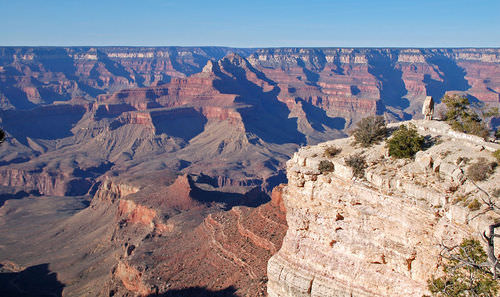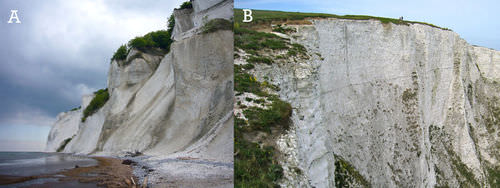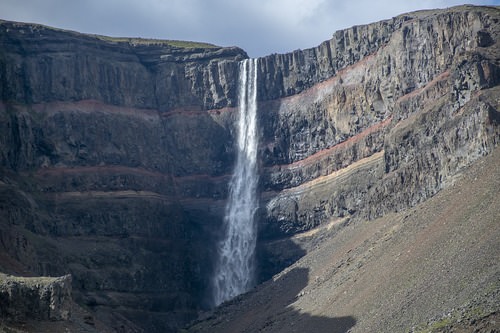2.3岩石的相对年龄
章节大纲
-
Lesson Objectives
::经验教训目标- Explain how stratigraphy can be used to determine the relative ages of rocks.
::解释如何利用地表学来确定岩石的相对年龄。
- State how unconformities occur.
::说明不一致情况是如何发生的。
- Identify ways to match rock layers in different areas.
::确定不同区域岩层的匹配方式。
- Describe how Earth’s history can be represented by the geologic time scale.
::描述地球历史如何可以用地质时间尺度来代表。
Lesson Vocabulary
::词汇表课程- geologic time scale
::地质时间尺度
- key bed
::键键床
- law of superposition
::叠加法
- relative age
::年龄 性别 年龄 性别 年龄 性别 年龄 年龄 性别 年龄 年龄 年龄 年龄 年龄 年龄 年龄 年龄 年龄 年龄 年龄 年龄 年龄 年龄 年龄 年龄 年龄 年龄 年龄 年龄 年龄 年龄 年龄 年龄 年龄 年龄 年龄 年龄 年龄 年龄 年龄 年龄 年龄 年龄 年龄 年龄 年龄 年龄 年龄 年龄 年龄 年龄 年龄 年龄 年龄 年龄 年龄 年龄 年龄 年龄 年龄 年龄
- stratigraphy
::地形学
- unconformity
::不符合同
Introduction
::导言Earth processes have not changed over time. The way things happen now is the same way things happened in the past. Mountains grow and mountains slowly wear away. The same process is at work the same as it was billions of years ago. As the environment changes, living creatures adapt. They change over time. Some organisms may not be able to adapt. They become extinct. Becoming extinct means they die out completely.
::地球过程没有随时间而变化。事情的发生方式与过去一样。 山岳生长和山岳慢慢消逝。 同样的过程也和数十亿年前一样。 随着环境的变化, 生物会适应变化。 它们随着时间的变化而变化。 有些生物可能无法适应。 它们已经灭绝了。 灭绝意味着它们将完全灭绝。Some geologists study the history of the Earth. They want to learn about Earth's past. They use clues from rocks and fossils. They use these clues to make sense of events. The goal is to place things in the order they happened. They also want to know how long it took for those events to happen.
::一些地质学家研究地球的历史。 他们想要了解地球的过去。 他们使用岩石和化石的线索。 他们使用这些线索来了解事件。 目的是按照事件发生的顺序排列事情。 他们还想知道这些事件要多久才会发生。Laws of Stratigraphy
::地层法法Consider the study of the layers of rock. Layers of rock are called strata. The study of strata is called stratigraphy . A lot can be learned by looking at layers of rock. Scientists can learn about past environments. From fossils, they can learn about what plants and animals once lived in the area. If they know what type of plant or animal lived in an area, they can get a good idea about the type of climate. The fossil evidence will tell them if the area was land or marine. Even the type of rock can tell them about the past environment. The laws of stratigraphy can help scientists learn many things about Earth’s past.
::研究岩石的层层。 岩石的层层被称为层层。 层层的研究称为层层学。 通过研究岩层可以学到很多东西。 科学家们可以了解过去的环境。 从化石中,他们可以了解曾经生活在这个地区的动植物。 如果他们知道一个地区是哪种植物或动物,他们就能很好地了解气候的类型。 化石证据可以告诉它们这个地区是陆地还是海洋。 即使是那类岩石也可以告诉他们过去的环境。 地层学法则可以帮助科学家们了解关于地球过去的许多事情。Law of Superposition
::超置定律Superposition refers to the position of rock layers. A lot can be learned by the position of rocks. We know the rocks on top are always younger than the rocks below. Knowing the relative age of rocks is very important to scientists. Relative age means age in comparison with other rocks. Are rocks older or younger than other rocks? The relative ages of rocks are important. They help scientists learn more about Earth’s history. New rock layers are always deposited on top of existing rock layers. Therefore, deeper layers must be older than layers closer to the surface. This is the law of superposition . You can see an example in Figure .
::叠加位置指岩石层的位置。 岩石的位置可以学到很多东西。 我们知道, 上面的岩石总是比下面的岩石要小。 了解岩石的相对年龄对于科学家来说非常重要。 相对年龄意味着年龄与其他岩石相比是十分重要的。 相对年龄是指年龄; 岩石比其他岩石要老还是小? 相对年龄很重要。 它们有助于科学家更多地了解地球的历史。 新的岩石层总是沉积在现有岩石层之上。 因此, 深层必须比靠近地表的层要老。 这是超常法则。 您可以在图中看到一个例子 。Superposition. The rock layers at the bottom of this cliff are much older than those at the top. What force eroded the rocks and exposed the layers?
::叠加。 悬崖底部的岩石层比顶部的要老得多。 是什么力量侵蚀了岩石,暴露了层层?Law of Lateral Continuity
::横向连续性法律Rock layers extend laterally, or out to the sides. They may cover very large areas. This is especially true if they formed at the bottom of ancient seas. Seas are very large areas of water. Over time, sediment builds up on the seabed. They will be covered with the same types of material. As rocks form out of this sediment it will all be the same type. The rocks may be forced up above the water as Earth's plates move. Rivers may eventually run across this area. The river will cut into the rock and erode it away. The layers of exposed rock on either side of the river will still “match up.”
::岩层横向延伸, 或伸向两侧。 它们可能覆盖非常大的区域。 如果在古代海洋底部形成, 情况尤其如此。 海是很大的水域。 随着时间的推移, 沉积会堆积在海底上, 它们将会被同样的材料覆盖。 当岩石从这个沉积物中形成时, 它们将会是相同的类型。 当地球板块移动时, 岩石可能被迫在水上方。 河流最终可能横跨这个区域。 河流会切入岩石, 并侵蚀它。 河两岸的暴露岩层仍然会“ 汇合 ” 。Look at the Grand Canyon in Figure . It’s a good example of lateral continuity. You can clearly see the same rock layers on opposite sides of the canyon. The matching rock layers were deposited at the same time. They are the same age.
::看看图中的大峡谷。这是一个横向连续性的好例子。你可以清楚地看到峡谷对面的同样的岩石层。相匹配的岩石层同时沉积。它们都是同龄人。Lateral Continuity. Layers of the same rock type are found across canyons at the Grand Canyon.
::在大峡谷的峡谷上发现了同一类型岩石的层层。Law of Original Horizontality
::原始水平定律Sediments were deposited in ancient seas in horizontal, or flat, layers. If sedimentary rock layers are tilted, they must have moved after they were deposited.
::如果沉积岩层倾斜,沉积层必须在沉积后移动。Law of Cross-Cutting Relationships
::交叉关系法Rock layers may have another rock cutting across them, like the igneous rock in Figure . Which rock is older? To determine this, we use the law of cross-cutting relationships. The cut rock layers are older than the rock that cuts across them.
::岩石层可能会有另一块岩石横穿它们, 就像图中的皮质岩石。 哪块岩石更老? 要确定这一点, 我们使用交叉关系法则。 剪切的岩石层比横穿它们的岩石要老。Cross-cutting relationships in rock layers. Rock D is a dike that cuts across all the other rocks. Is it older or younger than the other rocks?
::岩石层的交叉关系。 Rock D 是一个横跨所有其他岩石的堤坝。 它比其他岩石大还是小?Matching Rock Layers
::匹配摇滚层It is easy to match rock layers across a river. Unfortunately, matching rock layers is not always that easy. Sometimes, rock layers are not in the same place. They may be on different continents. So how do we match rock layers in this case? What evidence can we use to match the layers?
::很容易在河流上匹配岩石层。 不幸的是,匹配岩石层并不总是那么容易。 有时,岩石层不在同一地方。 它们可能在不同大陆上。 那么在这种情况下我们如何匹配岩石层? 我们用什么证据来匹配这些层?Widespread Rock Layers
::环状岩层Some rock layers extend over a very wide area. They may even be found on more than one continent. For example, the famous White Cliffs of Dover are on the coast of southeastern England. These are very distinctive rocks. They can be matched to similar white cliffs in France, Belgium, Holland, Germany, and Denmark (see Figure ). Why is this important to us? As it turns out, these cliffs are made of chalk. Chalk is a very soft rock. This rock extends from England to Europe. It extends under the English Channel. Because it is soft the Channel Tunnel connecting England and France was carved into it!
::有些岩石层延伸到一个宽广的区域, 甚至可能在一个以上的大陆上找到。 例如, 著名的多佛白裂谷位于英格兰东南部的海岸。 这些是非常独特的岩石。 它们可以与法国、比利时、荷兰、德国和丹麦类似的白色悬崖相匹配(见图 )。 为什么这对我们很重要? 事实证明, 这些悬崖是用粉笔制成的。 Chalk是一个非常柔软的岩石。 这块岩石从英格兰延伸到欧洲。 它在英吉利海峡下延伸。 因为连接英国和法国的海峡隧道是软的, 连接英国和法国的隧道被雕刻在里面!Chalk Cliffs. (A) Matching chalk cliffs in Denmark and (B) in Dover, U.K.
:A) 丹麦的粉笔悬崖和英国多佛的(B)粉笔悬崖相匹配。
Key Beds
::密钥床位Like index fossils, key beds are used to match rock layers. A key bed is a thin layer of rock. The rock must be unique and widespread. For example, a key bed from around the time that the dinosaurs went extinct is very important. A thin layer of clay was deposited over much of Earth’s surface. The clay has a large amount of the element iridium. Iridium is rare on Earth but common in asteroids. This unusual clay layer has been used to match rock layers all over the world. It also led to the hypothesis that a giant asteroid struck Earth. It was this event that may have caused dinosaurs to go extinct.
::像指数化石一样,钥匙床被用来匹配岩石层。钥匙床是一块薄薄的岩石层。岩石必须具有独特性和广度。例如,恐龙灭绝前后的密床非常重要。薄的粘土层沉积在地球大部分表面。粘土有大量的元素。在地球上是稀有的,但在小行星中很常见。这种不寻常的粘土层被用来匹配全世界的岩石层。它也导致一个巨型小行星撞击地球的假设。正是这一事件可能导致恐龙灭绝。Using Index Fossils
::使用化石指数Fossils can be used to match up rock layers. As organisms change over time, they look different. Older fossils will look different than younger fossils. Some organisms only survived for a short time before going extinct. Knowing what organisms looked like at certain times also helps date rock layers. Some fossils are better than others for this use. The fossils that are very distinct at certain times of Earth's history are called index fossils. Index fossils are commonly used to match rock layers. You can see how this works in Figure . If two rock layers have the same index fossils, then they’re probably about the same age.
::化石可以用来匹配岩石层。随着时间的变化,生物体会变化,它们看起来不同。老化石会看起来与年轻化石不同。有些生物体在灭绝之前只生存了很短的时间。知道在特定时间生物体的外观也会有助于日期岩石层。有些化石比其他生物更适合使用。在地球历史的某个时期非常不同的化石被称为指数化石。索引化石通常用来匹配岩石层。在图中可以看到这种作用。如果两个岩石层有相同的指数化石,那么它们大概也差不多是同一年代。Using Index Fossils to Match Rock Layers. Rock layers with the same index fossils must have formed at about the same time. The presence of more than one type of index fossil provides stronger evidence that rock layers are the same age.
::使用指数化石来匹配岩石层。 具有相同指数化石的岩石层必须同时形成。 不止一种指数化石的存在更有力地证明岩石层是同一年代的。Lesson Summary
::经验教训摘要- The study of rock layers is called stratigraphy. Laws of stratigraphy help scientists determine the relative ages of rocks. The main law is the law of superposition. This law states that deeper rock layers are older than layers closer to the surface.
::岩石层研究称为地层学,地层学法帮助科学家确定岩石的相对年龄。主要法系是叠加法系。该法指出,更深的岩石层比靠近地表的层老。
- Other clues help determine the relative ages of rocks in different places. They include key beds and index fossils.
::其他线索有助于确定不同地方岩石的相对年龄。 它们包括关键床位和指数化石。
Lesson Review Questions
::经验回顾问题Recall
::回顾1. Define stratigraphy.
::1. 界定地形。2. What is the relative age of a rock?
::2. 岩石的相对年龄是多少?3. State the law of superposition.
::3. 说明兼并法。4. How do key beds help date rock layers?
::4. 关键床位如何帮助约会岩石层?Apply Concepts
::应用概念5. Apply laws of stratigraphy to explain the rock formation below.
::5. 应用地表法则解释下面的岩层。6. Which rock in the illustration below formed first, the igneous rock (A) or the sedimentary rock (B)? Apply lesson concepts to support your answer.
::6. 以下插图中哪一个岩石首先形成,哪个是皮质岩石(A),还是沉积岩(B)?应用课程概念来支持你的答复。Think Critically
::仔细仔细思考7. Use the law of lateral continuity to explain why the same rock layers are found on opposite sides of the Grand Canyon.
::7. 使用横向连续性法解释为何在大峡谷对面发现同样的岩层。8. Why are sedimentary rocks more useful than metamorphic or igneous rocks in establishing the relative ages of rock?
::8. 为什么沉积岩在确定岩石相对年龄方面比变形或有色岩石更有用?Points to Consider
::需要考虑的要点In this lesson, you read how scientists determine the relative ages of sedimentary rock layers. The law of superposition determines which rock layers are younger or older than others.
::在这个教训中,您读到科学家如何确定沉积岩层的相对年龄。 叠加法则决定了哪些岩石层比其他岩石层年轻或年长。- What about the actual ages of rocks? Is there a way to estimate their ages in years?
::那么岩石的实际年龄呢?有办法用年数来估计其年龄吗?
- Explain how stratigraphy can be used to determine the relative ages of rocks.






